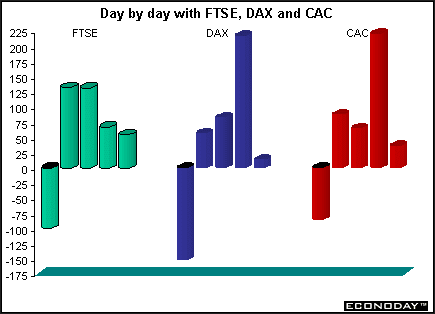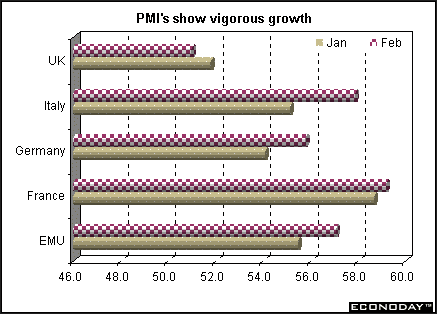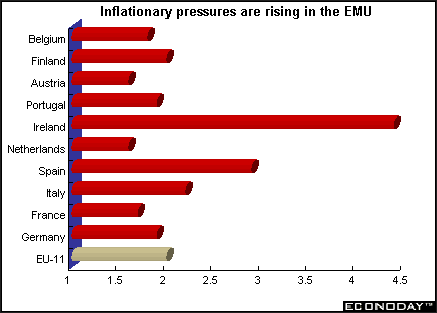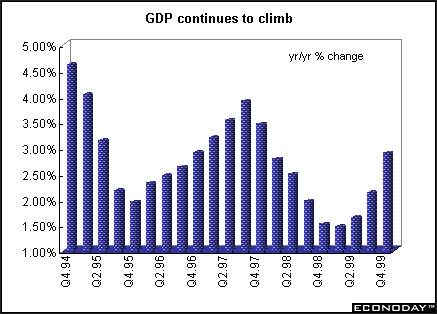| Previous Articles |
|
Asian and European markets follow U.S. markets Equities
Europe
In Europe, the main focus was the currency markets. The euro fell below $0.94 against the dollar in early Asian trading Monday but recovered quickly during the European and U.S. trading sessions later in the day. The apparent the reason for the drop was that traders decided as it turned out correctly, that the European Central Bank wouldn't raise interest rates at their monetary policy meeting on Thursday. However, after Monday's negatives, the CAC and DAX set new highs. The DAX was up 221.35 points or 2.86 percent to close the week at 7960.03. The CAC leapt 325.47 points or 5.26 percent to end the week at 6514.11. Asia
The strengthening yen put pressure on the Nikkei. The Japanese currency hit its highest level against the dollar in almost two weeks. That, in turn, hit major exporters, as investors worried that the strong yen would make exports more expensive overseas. On Wednesday and Thursday, the Nikkei finished above the 20,000 psychological level. On Friday Japanese investors, inclined to cash in gains before fiscal year end on March 31, took profits. On the week, the Nikkei jumped 109.66 points or 0.55 percent to end the week below 20,000 at 19927.54. Americas
Mexico - The Bolsa continued to soar to new record highs as the increasing likelihood of an investment grade credit rating prompted money managers to buy stocks. When and if the rating comes many more investors will see Mexico as a place to buy stocks, boosting demand. It will also make it cheaper for companies to borrow money, raising profits. As a result, the Mexican peso rose as foreign investors poured cash into Mexico's soaring stock market, sending it to an all-time high. The Bolsa was catapulted 11.32 percent or 827 points to close the week at 8131. Currencies
The Nikkei, which is viewed as an indicator of Japan's economic health, climbed once again above 20,000 and renewed foreign and domestic investors' interest. The greater demand for the currency drives the yen higher. But not all factors point to a stronger yen. The expected decline in fourth quarter gross national product, which will be announced this week or next, could weigh down the currency. Euro
High U.S. growth continues to lure international investors to our shores, putting downward pressure on the euro. Analysts say that the euro has been hampered by the European Central Bank's reluctance so far to raise rates. A rate increase would shrink the U.S.'s rate advantage and make euro-denominated deposits more attractive. The euro's continuing decline has made imports more expensive, driving prices higher. Inflation across the euro region accelerated to 2 percent a year in January, the ECB's stated inflation limit The
European Central Bank does nothing Indicator
Scoreboard
Other
indicators January's harmonized consumer prices rose 0.2 percent on the month and 2.0 percent on the year. The annual rate was the highest since January 1997. The increase was mainly due to a surge in prices for energy products as well as for food, alcohol and tobacco. Core inflation - excluding energy, food, alcohol and tobacco - continued to be moderate, falling 0.1 percent on the month in January, but rising to 1.2 percent when compared with last year.
January seasonally adjusted unemployment rate remained unchanged from December at 9.6 percent and at its lowest level since October 1992. Of the nine EMU countries reporting data, unemployment rose in only two, remained unchanged in four and fell in three. Spain continued to show the highest unemployment rate and also posted the strongest rise to 15.1 percent from 14.9 percent. This was followed by followed by France (unchanged at 10.3 percent), Finland (unchanged at 10.0 percent), Germany (8.8 percent) and Belgium (8.6 percent). Austria showed the lowest unemployment rate, unchanged at 4.2 percent, followed by Portugal (4.2 percent), Ireland (unchanged at 5.8 percent) and Sweden (6.4 percent). Fourth quarter current account surplus declined when compared to the fourth quarter of 1998. The EMU recorded a fourth quarter current account surplus of E8.6 billion, down from E14.2 billion for the fourth quarter of the previous year. The surplus was slightly higher than the E8.0 billion recorded in the third quarter of 1999. Germany - Fourth quarter pan-German seasonally adjusted gross national product rose 0.7 percent and 2.3 percent when compared to last year. A slowdown in domestic demand excluding inventories dampened the growth. Net exports and inventories contributed most of the increase in fourth quarter GDP. Consumer spending rose 0.6 percent in the fourth quarter after a 0.7 percent increase in the third, while fourth quarter government spending fell 0.6 percent after being unchanged in the prior quarter. Equipment investment fell 0.3 percent in the fourth quarter after a rise of 0.7 percent in the previous period. Construction investment fell 0.9 percent after a 1.3 percent increase in the third quarter. Both export and import growth slowed in the fourth quarter, but exports fell faster.
France- January's seasonally adjusted unemployment rate slipped 0.1 point to 10.5 percent, according to the ILO definition (which excludes job seekers who did any work during the month). Compared to January 1999, when the ILO rate stood at 11.5 percent, unemployment was down 274,000 or 9.2 percent. The latest ILO rate is the lowest since September 1992.
Italy - January seasonally adjusted business confidence accelerated its long running climb in January, to reach its highest level since the series began in January 1994. The composite index of overall business confidence stood at 106 in January, up from December's 103, October's 101 and 100 in September. This headline figure is a composite of seasonally adjusted indicators for current inventory levels, current orders, and the future outlook for production. Spain - January nonseasonally adjusted producer prices rose a 0.7 percent on the month, due mainly to rising energy prices. The PPI rate rose 4.5 percent when compared with last year mainly due to a base effect from very low commodity and oil prices in the same period last year. Producer prices for intermediate goods - the category in which energy prices are listed and which accounts for almost half (about 47 percent) of the weighting in the producer price index - rose 1.1 percent on the month and 8.6 percent on the year. Energy prices were up 1.7 percent on the month and 19.7 percent on the year. Britain - Fourth quarter gross domestic product was up 0.8 percent on the quarter and up 2.9 percent when compared with last year. The quarterly growth rate was unrevised from the preliminary estimate but the annual rate was previously estimated at 2.7 percent. Service sector output rose by 0.9 percent on the quarter and was up 2.9 percent on the year. Production industries' output growth in the fourth quarter rose by only 0.3 percent on the quarter and was up 1.8 percent on the year.
The CIPS report on services business activity index increased to 57.3 in February from 57.0 in January Price and pressures also picked up, according to the Chartered Institute of Purchasing and Supply. The latest activity expansion of activity reflects ongoing growth of incoming new business, which registered the fastest growth since last August. The February Halifax house price index fell 0.9 percent on the month but was up 15.0 percent on the year (down from 16.0 percent last month). This followed two strong monthly jumps of 2.5 percent in January and 2.6 percent in December and may be an indication that the pace of house price growth is beginning to ease. This is a market moving indicator and one that the Bank of England monitors closely in its policy deliberations.
February growth in retail sales volumes picked up to reach the fastest rate since November 1996, according to the Confederation of British Industry. Their trades' survey shows the sales volume balance at 47 percent compared with 29 percent in January and only 2 percent in February 1999. Sales also far exceeded retailers' expectations, which showed a balance of 21 percent. This has boosted retailers' confidence to a three year high. The confidence balance stood at 28 percent compared with 19 percent in November and 6 percent a year earlier. Asia February's trade surplus was about $800 million in February compared to a deficit of $391 million in January and a surplus of $1.7 billion a year earlier. Exports rose 37.3 percent on the year while imports grew 57.5 percent. China - Fourth quarter gross domestic product rose 6.8 percent when compared with last year. GDP rose 7.1 percent in 1999. Full year exports grew 6.1 percent annually while imports were up 18.2 percent. China's actual foreign direct investment in 1999 reached $40.4 billion. Japan - January seasonally adjusted unemployment rate remained at 4.7 percent. The number of employed persons in January was 63.55 million, an increase of 250,000, or 0.4 percent, from the previous year. January seasonally adjusted industrial production rose 0.9 percent on the month and was up 7.2 percent on the year on an unadjusted basis. Electrical machinery, general machinery and iron and steel were the main industrial contributors to the increase while personal computers, rolling stock and rechargeable batteries were the main commodity contributors. Inventories increased 1.1 percent on the month, adjusted for seasonal factors, and showed an unadjusted 4.0 percent decrease on the year, while the inventory ratio rose 0.6 percent over December and fell 5.4 percent over January a year earlier. Shipments rose 2.3 percent on the month and were up 6.3 percent on the year. Australia - January seasonally adjusted retail sales dropped 0.4 percent on the month but rose 3.1 percent when compared with last year. Analysts said that this year's economic statistics would be difficult to interpret because of likely distortions from the July 1 introduction of a 10 percent tax on goods and service and the 2000 Olympic Games in Sydney in September. Fourth quarter current account deficit narrowed to 7.96 billion Australian dollars (US$4.85 billion) in the December 1999 quarter from September's A$9.39 billion. Analysts said that the numbers confirm the September quarter was the peak and the deficit should improve going forward. This should provide some relief for the Australian dollar which has been declining. The Australian dollar has been hammered in recent weeks to near 17-month lows, confounding the analysts that had predicted rising commodity prices would take the pressure off of the currency. Americas
December gross domestic product at factor cost advanced by 0.4 percent, pushing fourth quarter growth to 1.1 percent. This was the 17th consecutive monthly increase, surpassing a mark set in 1988. Construction, manufacturing and retail trade led December's economic growth. Each accounted for more than 20 percent of the monthly increase. Business services financial services and utilities also made significant contributions. Manufacturing output rose 0.5 percent after a 1.8 percent surge in the previous month. Manufacturing output vaulted 6.3 percent in 1999 and above its 1998 level. December production was higher in 16 of the 22 major industry groups, representing 82.7 percent of total manufacturing. The largest contributors were makers of machinery, automotive and chemical products. BOTTOM
LINE Looking
Ahead: March 6 to March 10, 2000
Release dates are subject
to change. |
||||||||||||||||||||||||||||||||||||||||||||||||||||||||||||||||||||||||||||||||||||||||||||||||||||||||||||||||||||||||||||||||||||||||||||||||||||||||||||||||||||||||||||||||||||||











